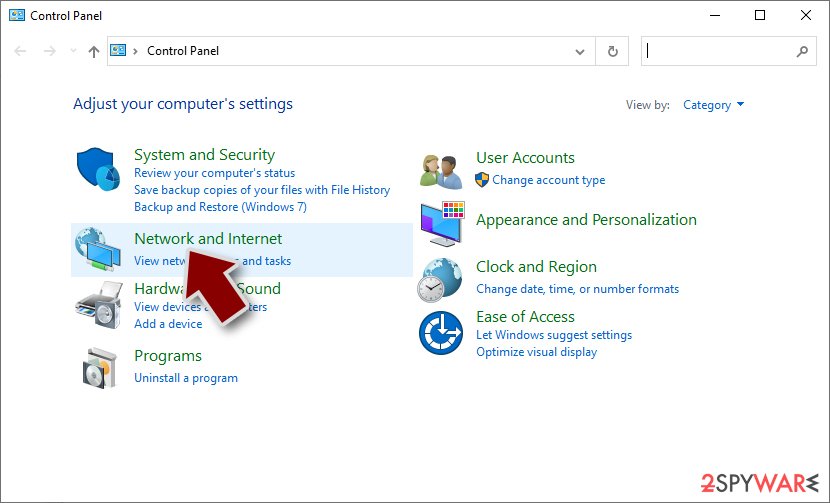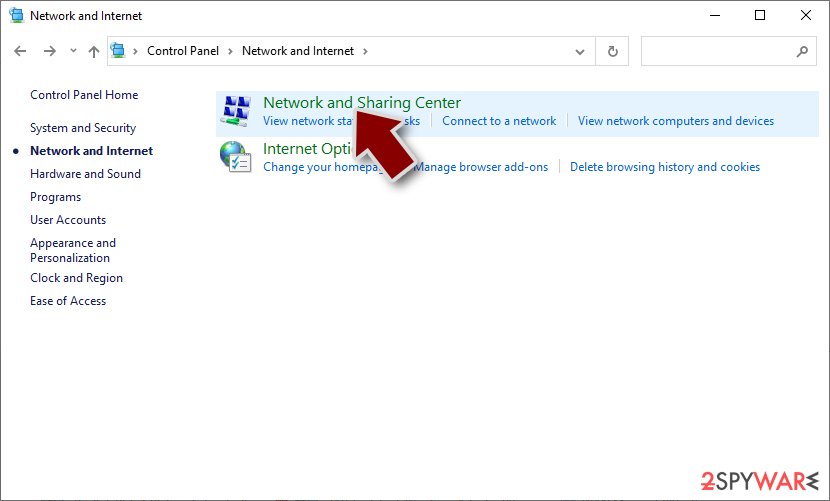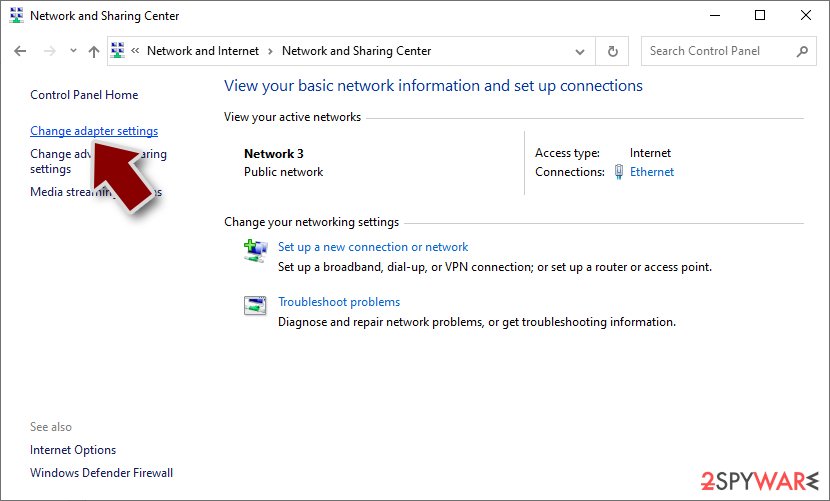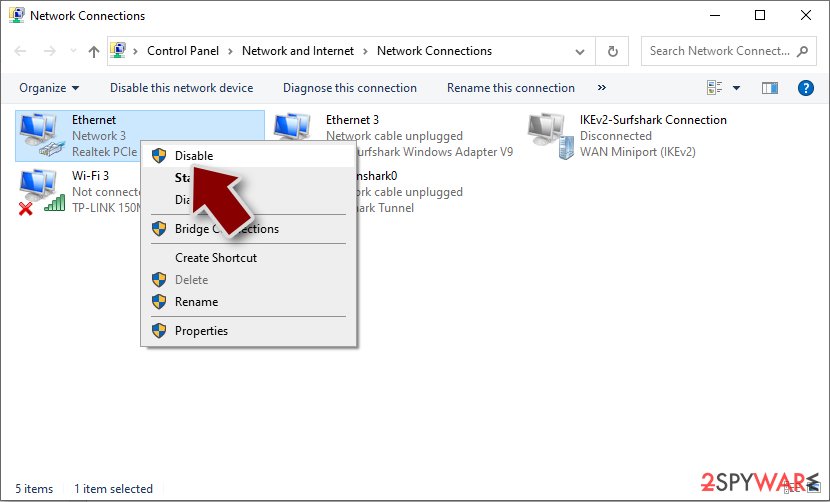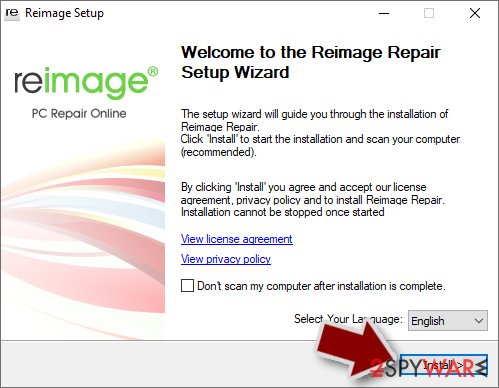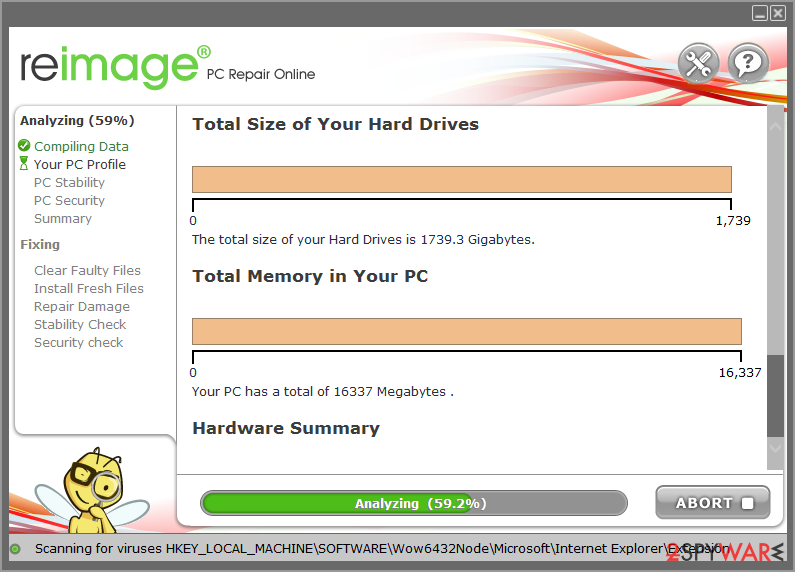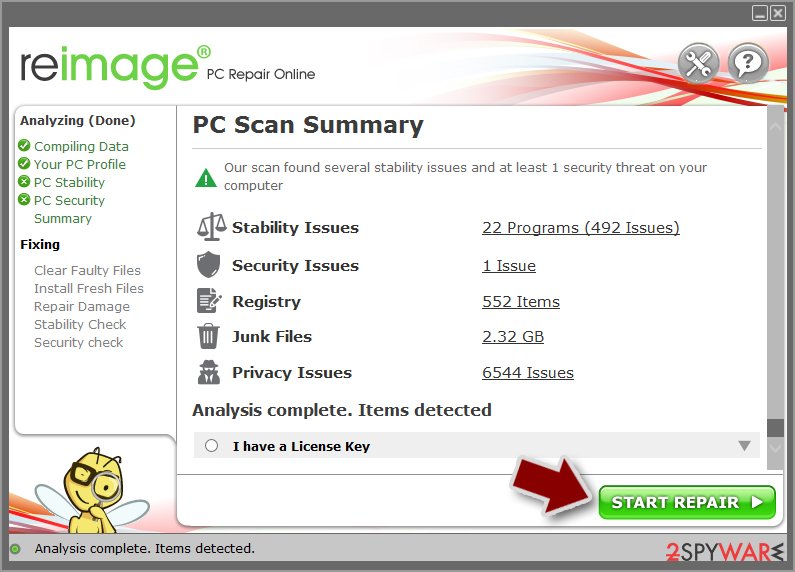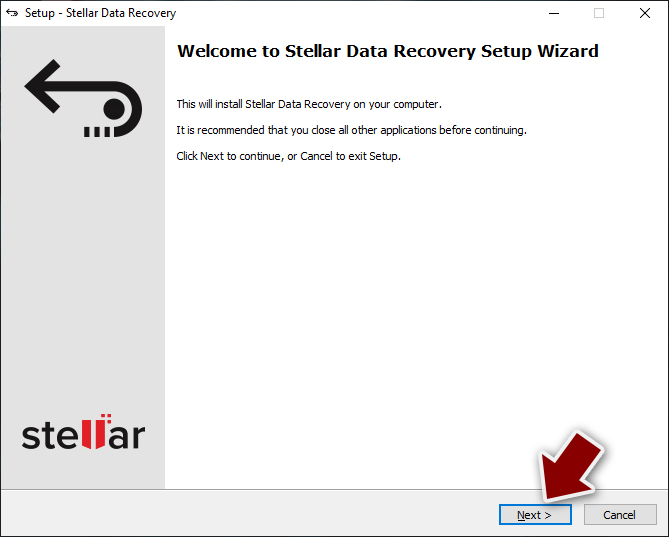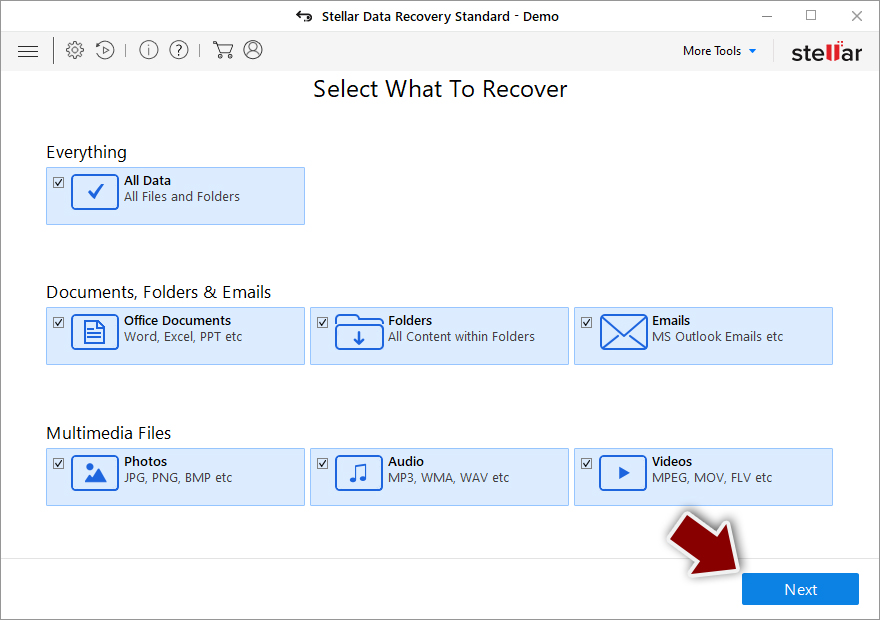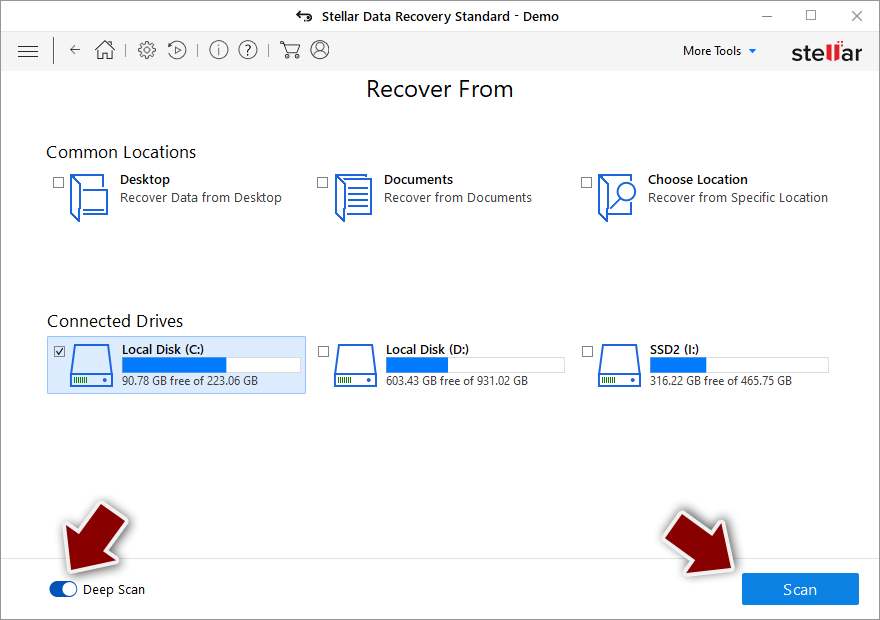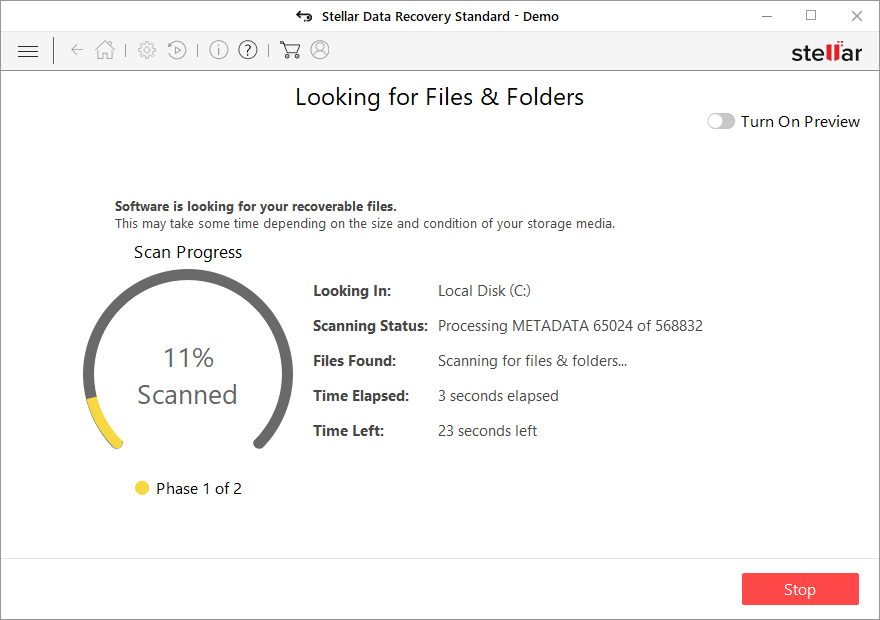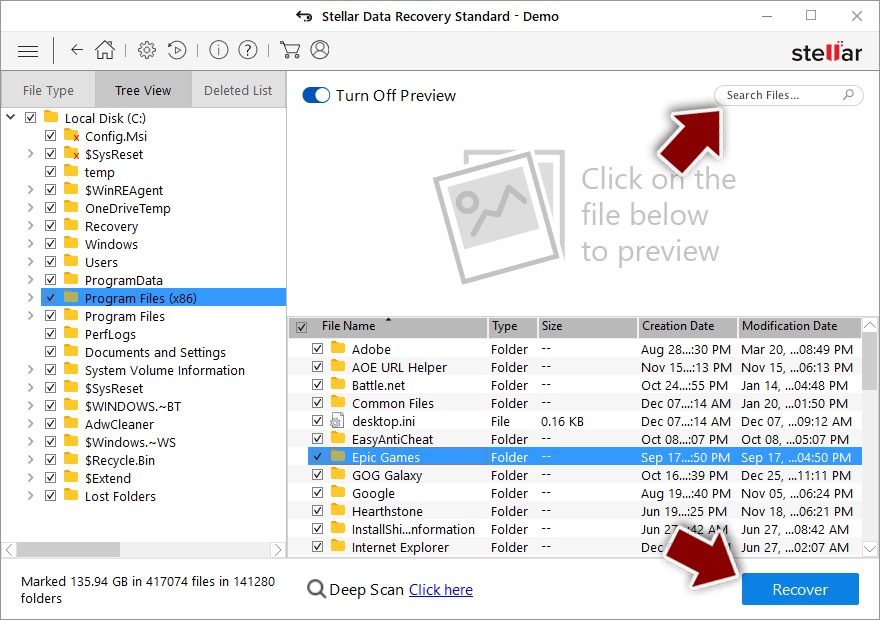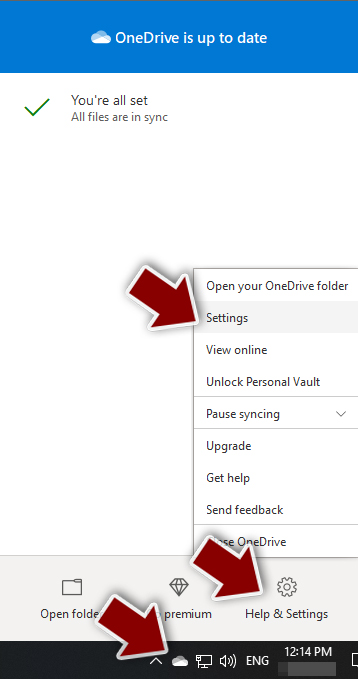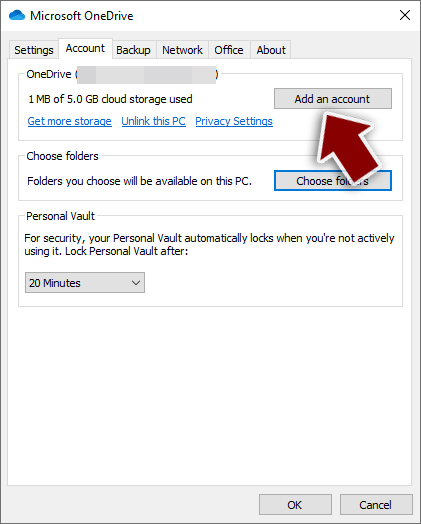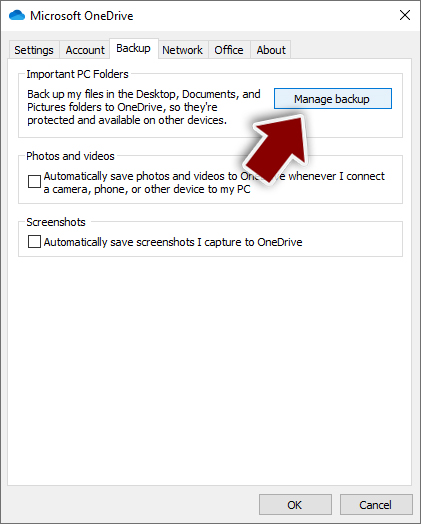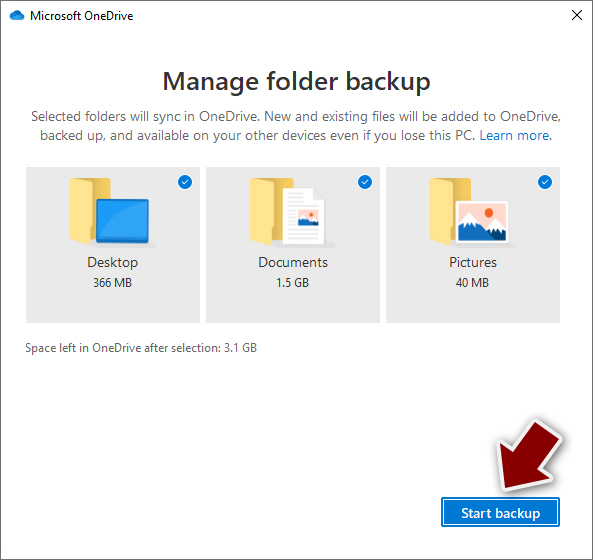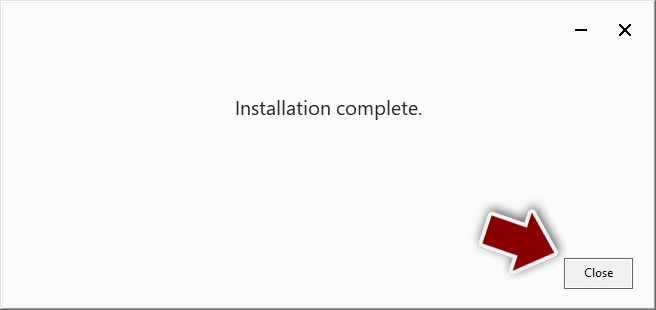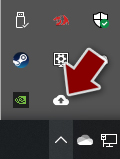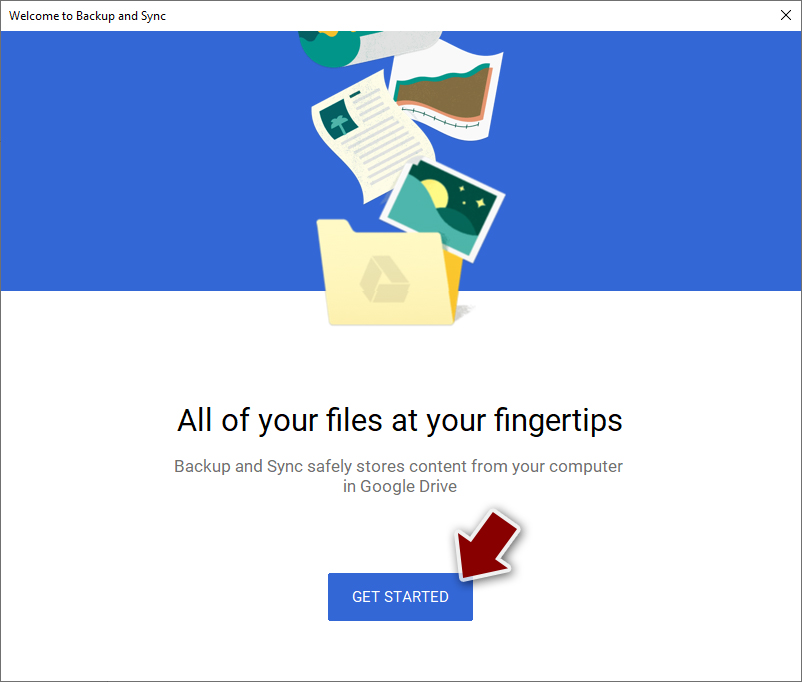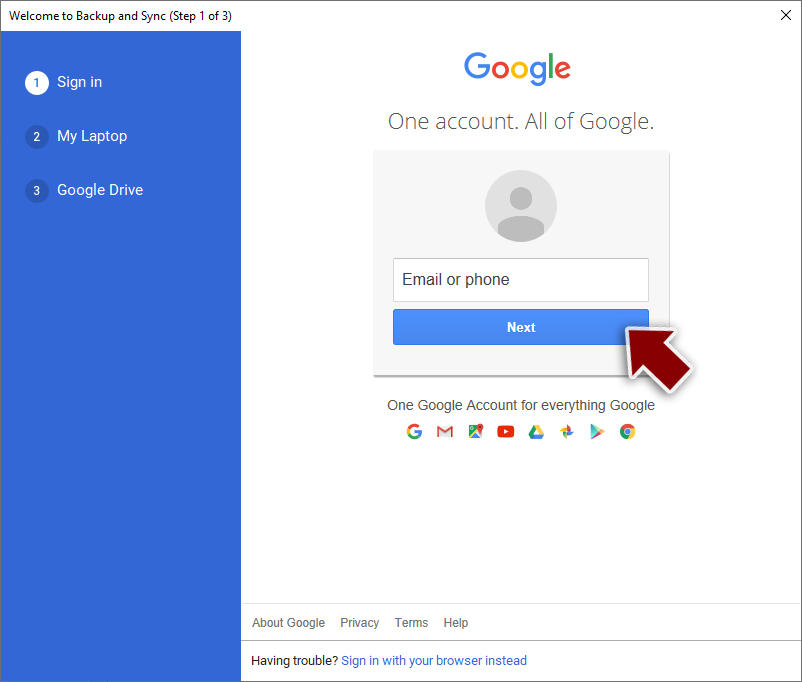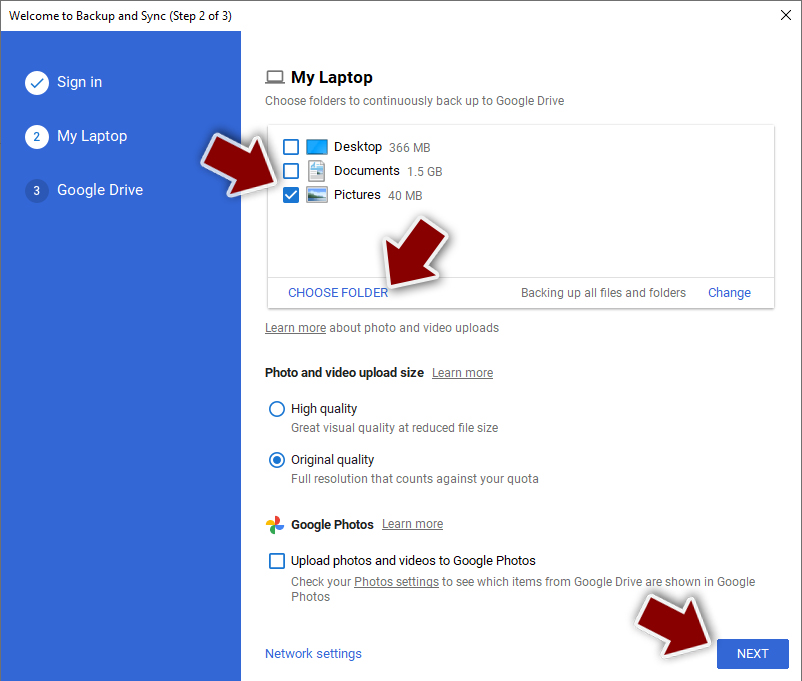XeroWare ransomware (Removal Guide) - Decryption Steps Included
XeroWare virus Removal Guide
What is XeroWare ransomware?
XeroWare ransomware – a virus that aims to extort money from people
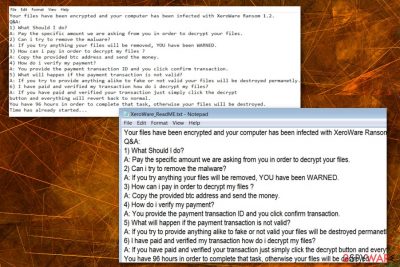
XeroWare ransomware is a cryptovirus that locks the victim's data and displays a ransom note with FAQs. This virus encrypts files and makes them useless using .XERO file extension. According to experts, malware is built on an open-source platform called HiddenTear[1] which has been known since 2015. Cybercriminals have used this platform countless times because it is an easy way to create new variants of viruses and make money. This virus encrypts targeted user's files using the AES encryption method and demands a ransom of 1.2 BTC (at the moment of writing, equal to $9,127)[2] to restore access to these files. After this data is marked with the appendix, the virus installs the ransom message called XeroWare_ReadME.txt on every folder on the system.
| Name | XeroWare |
|---|---|
| Type | Ransomware |
| Extension | .XERO |
| Encryption method | AES |
| Ransom amount | 1.2 BTC |
| Ransom note | XeroWare_ReadME.txt |
| Time | 96 hours is the period that criminals give for the vistims |
| Distribution | Spam email attachments |
| Elimination | Use anti-malware tools for the proper ransomware removal |
| Repair | The machine can be affected further, so rely on FortectIntego and system function recovery |
The virus can encrypt anything from photos and videos to music files or business documents. XeroWare ransomware virus makes these files no longer available for the user because it aims to make its victim pay the money in the form of ransom. After looking at the extension which is appended right after the AES encryption is finished, you can know that you are in real trouble as your files are encrypted and cannot be used anymore.
The only way to recover encrypted data is to replace corrupted files with clean ones. The easiest way to do that is by using the backup. However, you should remove the virus first because the virus can start another round of encryption. If you plug in an external hard drive while ransomware is still working on your system, you might lose your data again.
After the successful encryption, the virus places a ransom message with more facts about the attack itself. In this case, virus developers decided to answer frequently asked questions to help their victims deal with the current situation. The ransom note provides information on the ransom amount (it is 1.2 BTC) and the amount of time given (it should be less than 96 hours).
Otherwise, the virus promises to delete affected files for good. The ransom note also contains information about the payment itself. However, no matter how tempting the recovery of files might seem, you shouldn't pay the ransom because the people behind the virus are criminals and they should never be trusted.
The particular ransom message reads the following:
Your files have been encrypted and your computer has been infected with XeroWare Ransom 1.2. 1) What Should I do?
A: Pay the specific amount we are asking from you in order to decrypt your files.
2) Can i try to remove the malware?
A: If you try anything your files will be removed, YOU have been WARNED.
3) How can i pay in order to decrypt my files ?
A: Copy the provided btc address and send the money.
4) How do i verify my payment?
A: You provide the payment transaction ID and you click confirm transaction.
5) What will happen if the payment transaction is not valid?
A: If you try to provide anything alike to fake or not valid your files will be destroyed permanently.
6) I have paid and verified my transaction how do i decrypt my files?
A: If you have paid and verified your transaction just simply click the decrypt button and everything will revert back to normal.
You have 96 hours in order to complete that task, otherwise your files will be destroyed.
Time has already started…
Just like any other crypto-malware, this virus gives you an ultimatum to pay the fee and unlock your files or say goodbye to encrypted data. According to its developers, they can automatically corrupt your files or delete them if the payment is not received. However, there is also a possibility that this decryption key does not exist and attackers have no decryption tool to give you after you pay. They might just disappear with your money.
You need to perform XeroWare removal as soon as you notice .XERO file extension added to your files or see the ransom message. The more time you give to this virus, the more changes it can make to your system. Use anti-malware tools like FortectIntego to get rid of the virus without wasting your time. You should also check our step-by-step guide and data recovery tools to prevent issues related to the full removal of this malware.
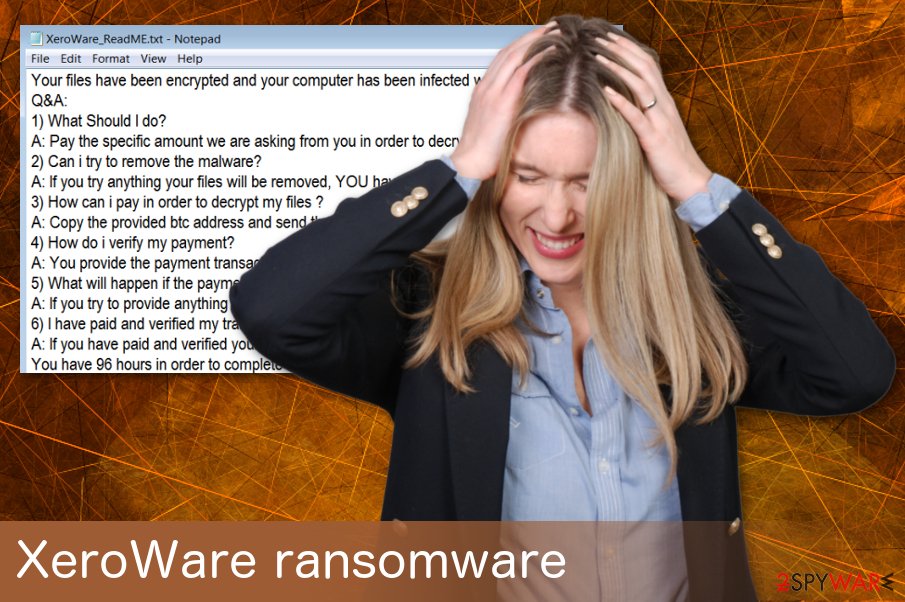
Various spam email campaigns are used to spread cyber infections
The virus can be spread using various methods. However, the most common is related to spam emails. Phishing emails[3] contain malicious links redirecting their victims to malware-hosting websites or file attachments filled with macro-viruses. Documents in various formats might be infected and spread ransomware or other infections immediately after you open the downloaded file on the computer.
To prevent this kind of scenario, researchers[4] are actively recommending staying away from spam. Make sure you double-check your email box and remove emails that are misleading. Also, check the sender and message body to make sure that the email message is legit. You can even contact the sender to ask him/her about the “invoice,” “report,” and similar document in your inbox.
XeroWare ransomware termination requires attention
To remove the dangerous program, you should rely on legitimate anti-malware tools like SpyHunter 5Combo Cleaner or Malwarebytes. These programs will help you look thru your computer system and will also detect every file that belongs to this malware or other cyber infections. If you find your anti-malware tool blocked by this virus, use the steps given below to disable the virus first. Additionally, launch your antivirus and run a scan several times to make sure that your malware is gone.
XeroWare removal is not that difficult if you pay enough attention to the tips provided by security experts. Getting trusted software when terminating malware is also a crucial step. Otherwise, you can run into further issues related to cryptovirus as it can add/remove registry entries, disable important executable files and initiate other malicious activities on your computer. To fix those issues you can rely on FortectIntego.
Getting rid of XeroWare virus. Follow these steps
Isolate the infected computer
Some ransomware strains aim to infect not only one computer but hijack the entire network. As soon as one of the machines is infected, malware can spread via network and encrypt files everywhere else, including Network Attached Storage (NAS) devices. If your computer is connected to a network, it is important to isolate it to prevent re-infection after ransomware removal is complete.
The easiest way to disconnect a PC from everything is simply to plug out the ethernet cable. However, in the corporate environment, this might be extremely difficult to do (also would take a long time). The method below will disconnect from all the networks, including local and the internet, isolating each of the machines involved.
- Type in Control Panel in Windows search and press Enter
- Go to Network and Internet

- Click Network and Sharing Center

- On the left, pick Change adapter settings

- Right-click on your connection (for example, Ethernet), and select Disable

- Confirm with Yes.
If you are using some type of cloud storage you are connected to, you should disconnect from it immediately. It is also advisable to disconnect all the external devices, such as USB flash sticks, external HDDs, etc. Once the malware elimination process is finished, you can connect your computers to the network and internet, as explained above, but by pressing Enable instead.
Scan your system with anti-malware
If you are a victim of ransomware, you should employ anti-malware software for its removal. Some ransomware can self-destruct after the file encryption process is finished. Even in such cases, malware might leave various data-stealing modules or could operate in conjunction with other malicious programs on your device.
SpyHunter 5Combo Cleaner or Malwarebytes can detect and eliminate all ransomware-related files, additional modules, along with other viruses that could be hiding on your system. The security software is really easy to use and does not require any prior IT knowledge to succeed in the malware removal process.
Repair damaged system components
Once a computer is infected with malware, its system is changed to operate differently. For example, an infection can alter the Windows registry database, damage vital bootup and other sections, delete or corrupt DLL files, etc. Once a system file is damaged by malware, antivirus software is not capable of doing anything about it, leaving it just the way it is. Consequently, users might experience performance, stability, and usability issues, to the point where a full Windows reinstall is required.
Therefore, we highly recommend using a one-of-a-kind, patented technology of FortectIntego repair. Not only can it fix virus damage after the infection, but it is also capable of removing malware that has already broken into the system thanks to several engines used by the program. Besides, the application is also capable of fixing various Windows-related issues that are not caused by malware infections, for example, Blue Screen errors, freezes, registry errors, damaged DLLs, etc.
- Download the application by clicking on the link above
- Click on the ReimageRepair.exe

- If User Account Control (UAC) shows up, select Yes
- Press Install and wait till the program finishes the installation process

- The analysis of your machine will begin immediately

- Once complete, check the results – they will be listed in the Summary
- You can now click on each of the issues and fix them manually
- If you see many problems that you find difficult to fix, we recommend you purchase the license and fix them automatically.

By employing FortectIntego, you would not have to worry about future computer issues, as most of them could be fixed quickly by performing a full system scan at any time. Most importantly, you could avoid the tedious process of Windows reinstallation in case things go very wrong due to one reason or another.
Restore Windows "hosts" file to its original state
Some ransomware might modify Windows hosts file in order to prevent users from accessing certain websites online. For example, Djvu ransomware variants add dozens of entries containing URLs of security-related websites, such as 2-spyware.com. Each of the entries means that users will not be able to access the listed web addresses and will receive an error instead.
Here's an example of “hosts” file entries that were injected by ransomware:
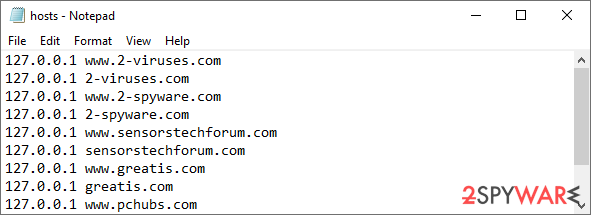
In order to restore your ability to access all websites without restrictions, you should either delete the file (Windows will automatically recreate it) or remove all the malware-created entries. If you have never touched the “hosts” file before, you should simply delete it by marking it and pressing Shift + Del on your keyboard. For that, navigate to the following location:
C:\\Windows\\System32\\drivers\\etc\\
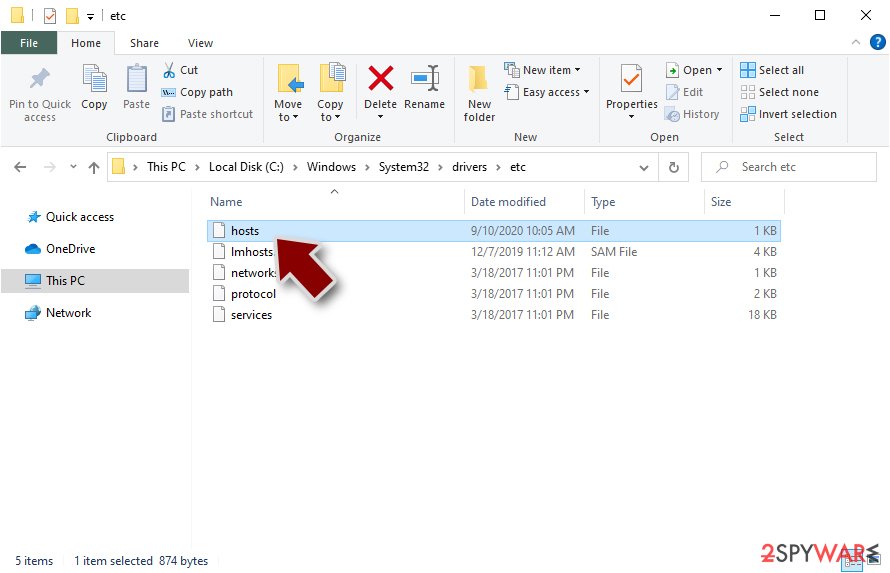
Restore files using data recovery software
Since many users do not prepare proper data backups prior to being attacked by ransomware, they might often lose access to their files permanently. Paying criminals is also very risky, as they might not fulfill the promises and never send back the required decryption tool.
While this might sound terrible, not all is lost – data recovery software might be able to help you in some situations (it highly depends on the encryption algorithm used, whether ransomware managed to complete the programmed tasks, etc.). Since there are thousands of different ransomware strains, it is immediately impossible to tell whether third-party software will work for you.
Therefore, we suggest trying regardless of which ransomware attacked your computer. Before you begin, several pointers are important while dealing with this situation:
- Since the encrypted data on your computer might permanently be damaged by security or data recovery software, you should first make backups of it – use a USB flash drive or another storage.
- Only attempt to recover your files using this method after you perform a scan with anti-malware software.
Install data recovery software
- Download Data Recovery Pro.
- Double-click the installer to launch it.

- Follow on-screen instructions to install the software.

- As soon as you press Finish, you can use the app.
- Select Everything or pick individual folders where you want the files to be recovered from.

- Press Next.
- At the bottom, enable Deep scan and pick which Disks you want to be scanned.

- Press Scan and wait till it is complete.

- You can now pick which folders/files to recover – don't forget you also have the option to search by the file name!
- Press Recover to retrieve your files.

Create data backups to avoid file loss in the future
One of the many countermeasures for home users against ransomware is data backups. Even if your Windows get corrupted, you can reinstall everything from scratch and retrieve files from backups with minimal losses overall. Most importantly, you would not have to pay cybercriminals and risk your money as well.
Therefore, if you have already dealt with a ransomware attack, we strongly advise you to prepare backups for future use. There are two options available to you:
- Backup on a physical external drive, such as a USB flash drive or external HDD.
- Use cloud storage services.
The first method is not that convenient, however, as backups need to constantly be updated manually – although it is very reliable. Therefore, we highly advise choosing cloud storage instead – it is easy to set up and efficient to sustain. The problem with it is that storage space is limited unless you want to pay for the subscription.
Using Microsoft OneDrive
OneDrive is a built-in tool that comes with every modern Windows version. By default, you get 5 GB of storage that you can use for free. You can increase that storage space, but for a price. Here's how to setup backups for OneDrive:
- Click on the OneDrive icon within your system tray.
- Select Help & Settings > Settings.

- If you don't see your email under the Account tab, you should click Add an account and proceed with the on-screen instructions to set yourself up.

- Once done, move to the Backup tab and click Manage backup.

- Select Desktop, Documents, and Pictures, or a combination of whichever folders you want to backup.
- Press Start backup.

After this, all the files that are imported into the above-mentioned folders will be automatically backed for you. If you want to add other folders or files, you have to do that manually. For that, open File Explorer by pressing Win + E on your keyboard, and then click on the OneDrive icon. You should drag and drop folders you want to backup (or you can use Copy/Paste as well).
Using Google Drive
Google Drive is another great solution for free backups. The good news is that you get as much as 15GB for free by choosing this storage. There are also paid versions available, with significantly more storage to choose from.
You can access Google Drive via the web browser or use a desktop app you can download on the official website. If you want your files to be synced automatically, you will have to download the app, however.
- Download the Google Drive app installer and click on it.

- Wait a few seconds for it to be installed.

- Now click the arrow within your system tray – you should see Google Drive icon there, click it once.

- Click Get Started.

- Enter all the required information – your email/phone, and password.

- Now pick what you want to sync and backup. You can click on Choose Folder to add additional folders to the list.
- Once done, pick Next.

- Now you can select to sync items to be visible on your computer.
- Finally, press Start and wait till the sync is complete. Your files are now being backed up.
Report the incident to your local authorities
Ransomware is a huge business that is highly illegal, and authorities are very involved in catching malware operators. To have increased chances of identifying the culprits, the agencies need information. Therefore, by reporting the crime, you could help with stopping the cybercriminal activities and catching the threat actors. Make sure you include all the possible details, including how did you notice the attack, when it happened, etc. Additionally, providing documents such as ransom notes, examples of encrypted files, or malware executables would also be beneficial.
Law enforcement agencies typically deal with online fraud and cybercrime, although it depends on where you live. Here is the list of local authority groups that handle incidents like ransomware attacks, sorted by country:
- USA – Internet Crime Complaint Center IC3
- United Kingdom – ActionFraud
- Canada – Canadian Anti-Fraud Centre
- Australia – ScamWatch
- New Zealand – ConsumerProtection
- Germany – Polizei
- France – Ministère de l'Intérieur
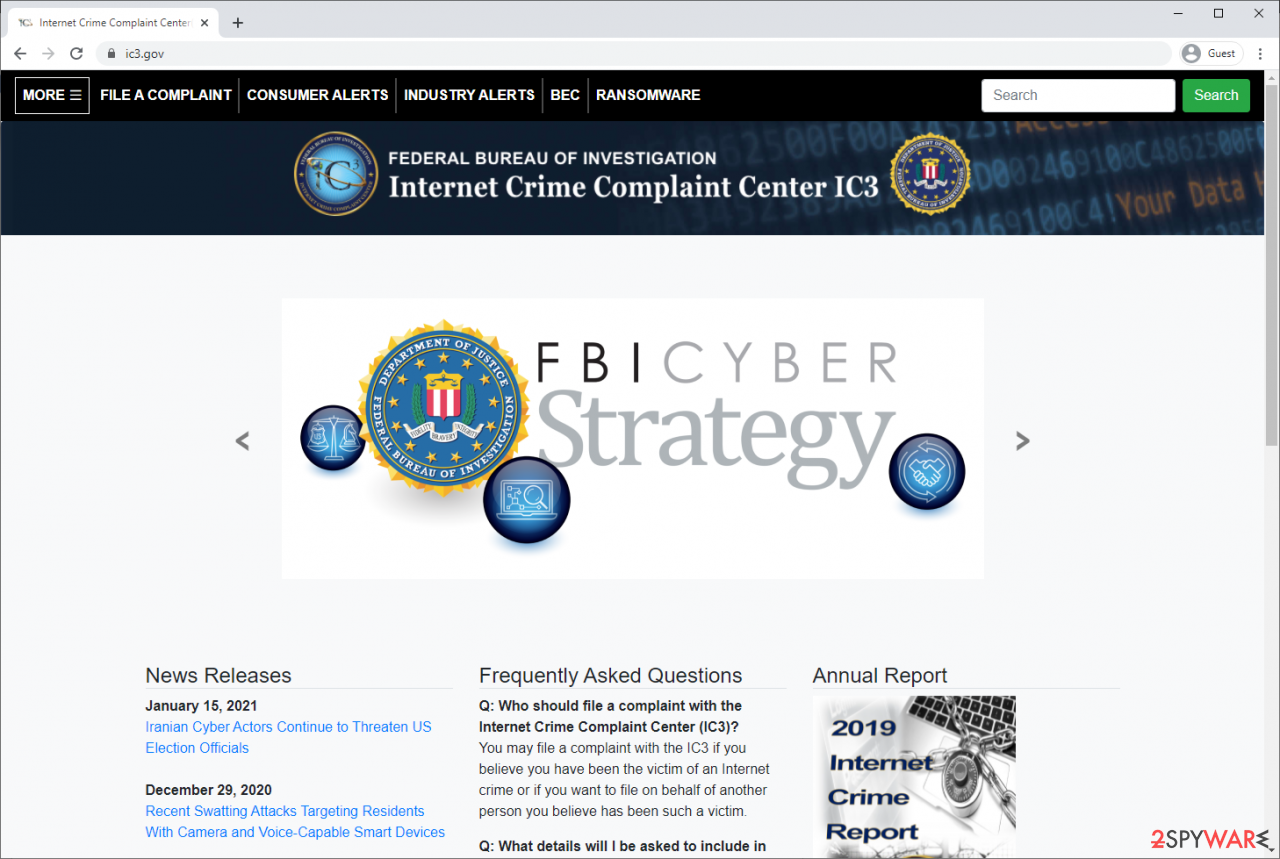
If your country is not listed above, you should contact the local police department or communications center.
Manual removal using Safe Mode
Important! →
Manual removal guide might be too complicated for regular computer users. It requires advanced IT knowledge to be performed correctly (if vital system files are removed or damaged, it might result in full Windows compromise), and it also might take hours to complete. Therefore, we highly advise using the automatic method provided above instead.
Step 1. Access Safe Mode with Networking
Manual malware removal should be best performed in the Safe Mode environment.
Windows 7 / Vista / XP
- Click Start > Shutdown > Restart > OK.
- When your computer becomes active, start pressing F8 button (if that does not work, try F2, F12, Del, etc. – it all depends on your motherboard model) multiple times until you see the Advanced Boot Options window.
- Select Safe Mode with Networking from the list.

Windows 10 / Windows 8
- Right-click on Start button and select Settings.

- Scroll down to pick Update & Security.

- On the left side of the window, pick Recovery.
- Now scroll down to find Advanced Startup section.
- Click Restart now.

- Select Troubleshoot.

- Go to Advanced options.

- Select Startup Settings.

- Press Restart.
- Now press 5 or click 5) Enable Safe Mode with Networking.

Step 2. Shut down suspicious processes
Windows Task Manager is a useful tool that shows all the processes running in the background. If malware is running a process, you need to shut it down:
- Press Ctrl + Shift + Esc on your keyboard to open Windows Task Manager.
- Click on More details.

- Scroll down to Background processes section, and look for anything suspicious.
- Right-click and select Open file location.

- Go back to the process, right-click and pick End Task.

- Delete the contents of the malicious folder.
Step 3. Check program Startup
- Press Ctrl + Shift + Esc on your keyboard to open Windows Task Manager.
- Go to Startup tab.
- Right-click on the suspicious program and pick Disable.

Step 4. Delete virus files
Malware-related files can be found in various places within your computer. Here are instructions that could help you find them:
- Type in Disk Cleanup in Windows search and press Enter.

- Select the drive you want to clean (C: is your main drive by default and is likely to be the one that has malicious files in).
- Scroll through the Files to delete list and select the following:
Temporary Internet Files
Downloads
Recycle Bin
Temporary files - Pick Clean up system files.

- You can also look for other malicious files hidden in the following folders (type these entries in Windows Search and press Enter):
%AppData%
%LocalAppData%
%ProgramData%
%WinDir%
After you are finished, reboot the PC in normal mode.
Finally, you should always think about the protection of crypto-ransomwares. In order to protect your computer from XeroWare and other ransomwares, use a reputable anti-spyware, such as FortectIntego, SpyHunter 5Combo Cleaner or Malwarebytes
How to prevent from getting ransomware
Choose a proper web browser and improve your safety with a VPN tool
Online spying has got momentum in recent years and people are getting more and more interested in how to protect their privacy online. One of the basic means to add a layer of security – choose the most private and secure web browser. Although web browsers can't grant full privacy protection and security, some of them are much better at sandboxing, HTTPS upgrading, active content blocking, tracking blocking, phishing protection, and similar privacy-oriented features. However, if you want true anonymity, we suggest you employ a powerful Private Internet Access VPN – it can encrypt all the traffic that comes and goes out of your computer, preventing tracking completely.
Lost your files? Use data recovery software
While some files located on any computer are replaceable or useless, others can be extremely valuable. Family photos, work documents, school projects – these are types of files that we don't want to lose. Unfortunately, there are many ways how unexpected data loss can occur: power cuts, Blue Screen of Death errors, hardware failures, crypto-malware attack, or even accidental deletion.
To ensure that all the files remain intact, you should prepare regular data backups. You can choose cloud-based or physical copies you could restore from later in case of a disaster. If your backups were lost as well or you never bothered to prepare any, Data Recovery Pro can be your only hope to retrieve your invaluable files.
- ^ What is Hidden Tear?. Wikipedia. The free encyclopedia.
- ^ The price of BTC. CoinDesk. The platform providing the latest and most accurate bitcoin price using an average from the world's leading exchanges.
- ^ What Is Phishing?. Phishing. The site instructing people about the cybercrime.
- ^ Avirus. Avirus. Spyware news.
